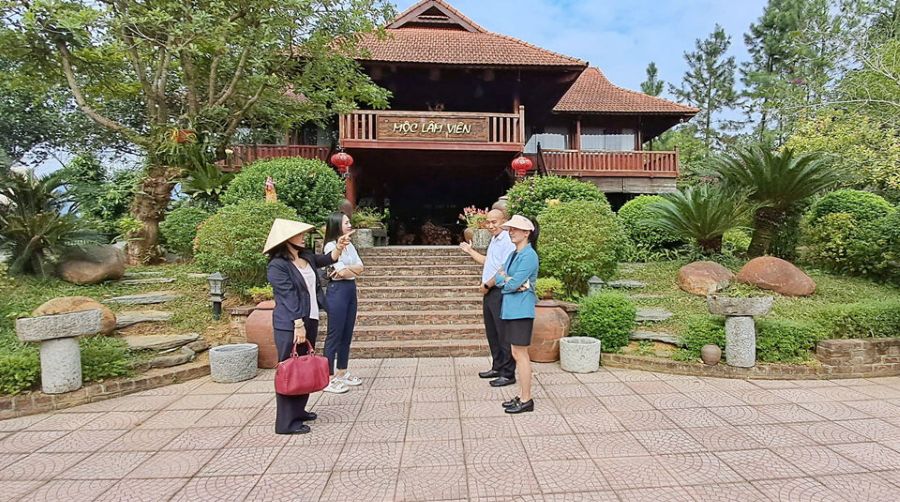Hanoi is making efforts to unlock the tourism potential of the suburban district of Chuong My.
The Hanoi Tourism Department, together with the Chuong My People’s Committee, on November 22 hosted a seminar focused on nurturing agricultural and rural community-based tourism models, aiming to transform Chuong My District into a vibrant, new-style rural area. This collaboration marks a hopeful step toward empowering the local community and unlocking the district’s rich cultural and natural potential.

Commenting on the tourism potential of the area, Duong Thi Thanh, Deputy Head of the Culture and Information Department of Chuong My District, shared that Chuong My, located southwest of Hanoi, is renowned for its many historic relics and scenic spots, including the iconic Tram Pagoda, the Hundred-Compartment (Tram Gian) Pagoda, and Vo Vi Pagoda.
Chuong My stands out as Hanoi’s top district for craft villages, boasting an impressive 175 traditional villages known for their unique handicrafts. The district is also blessed with stunning natural beauty, home to serene lakes like Dong Suong Lake and Van Son Lake, covering 203 and 167 hectares respectively. These peaceful spots are ideal for outdoor activities and recreational fishing. Adding to its charm, the Sky Lake Resort & Golf Club offers a luxurious retreat for upscale visitors, featuring two spectacular 18-hole golf courses, making Chuong My a truly captivating destination for all.
Thanks to its natural potential and strategic location in a semi-mountainous area, Chuong My District is ideally positioned to develop three key types of tourism: cultural-historical tourism, eco-tourism, and craft village tourism. To fully harness these strengths, Chuong My is focusing on establishing and operating a range of tourist sites, routes, and tours, aiming to showcase its rich cultural heritage, breathtaking landscapes, and traditional craftsmanship.

“Regarding cultural and historical tourist attractions, the district has developed a master plan for the Tram Pagoda tourist area, which spans 50 hectares. This plan aims to create a cultural tourism model that blends with eco-tourism, while also renovating and upgrading both Tram Pagoda and Tram Gian Pagoda to draw visitors from near and far,” said Thanh.
Despite its vast potential, Chuong My’s tourism development has yet to reach its full promise. According to the Culture and Information Department of Chuong My District, visitor numbers, though increasing in recent years, remain relatively modest. Several factors contribute to this, including insufficient infrastructure and facilities, as well as underutilized tourism resources. Furthermore, the promotion of Chuong My’s tourism has not received the attention it deserves, and its tourism offerings are still limited, lacking variety and appeal, which fail to fully captivate the interest of potential visitors.
To address these challenges, Nguyen Duc Thang, Head of the Faculty of Tourism at Dong A (East Asia) University of Technology, suggested that Chuong My District develop a comprehensive plan for community-based tourism, focusing on the district’s craft village products. He emphasized the importance of promoting green, sustainable growth to create a unique and eco-friendly tourism model that leverages the area’s cultural and natural assets.
At the same time, the promotion of craft village products should be strengthened, alongside the development of unique experiential offerings and improved accommodation services, encouraging tourists to extend their stays. Furthermore, it is crucial for local authorities and communities to ramp up efforts in promoting cultural and agro-tourism, as well as OCOP (One Commune One Product) products, to attract and engage more visitors.
“After visitors explore the relics and immerse themselves in the local culture, they will be eager to purchase agricultural products that meet their needs. This is when the community becomes both the supplier and the beneficiary of tourism,” Thang said.
The Hanoi Tourism Department’s support for suburban districts in developing community-based and green tourism not only helps stimulate the tourism industry but also diversifies rural livelihoods, offering new opportunities for local communities.
At the same time, it helps create more local jobs, boost residents’ income, preserve and promote traditional cultural values, and enhance both the material and emotional well-being of the local community.
Jenna Duong – Le Nam
- Hà Nội bứt tốc kích cầu du lịch
- 6 tháng đầu năm 2025, Hà Nội đón hơn 15,5 triệu lượt du khách
- Du lịch Hà Nội sẽ chuẩn bị tốt nhất phục vụ nhân dân và du khách dịp Đại lễ Quốc khánh 2/9
- Quận Hoàn Kiếm nâng tầm điểm đến du lịch trung tâm Thủ đô
- Hà Nội: Kích cầu du lịch với trải nghiệm ưu đãi tại các khách sạn 4-5 sao







